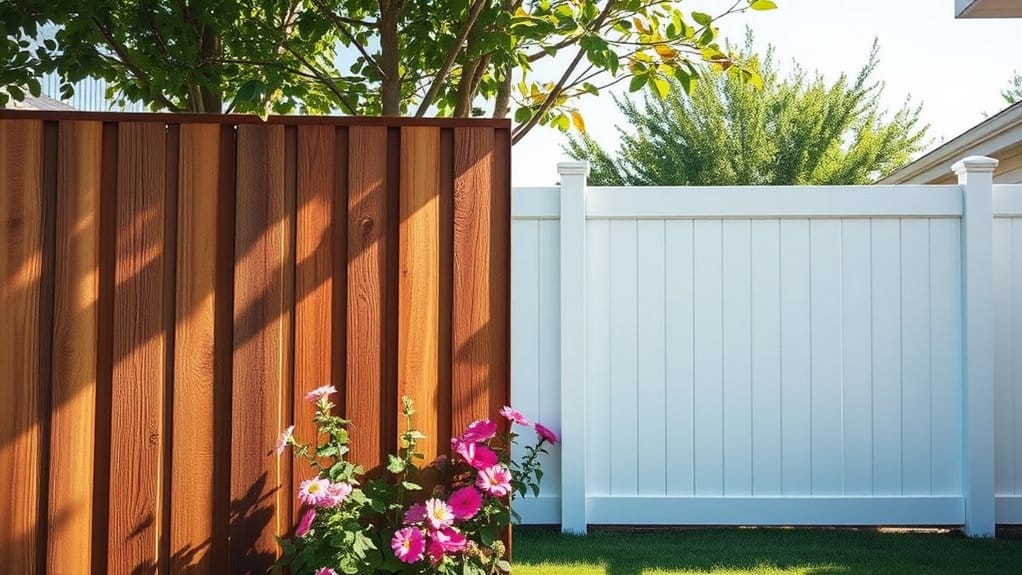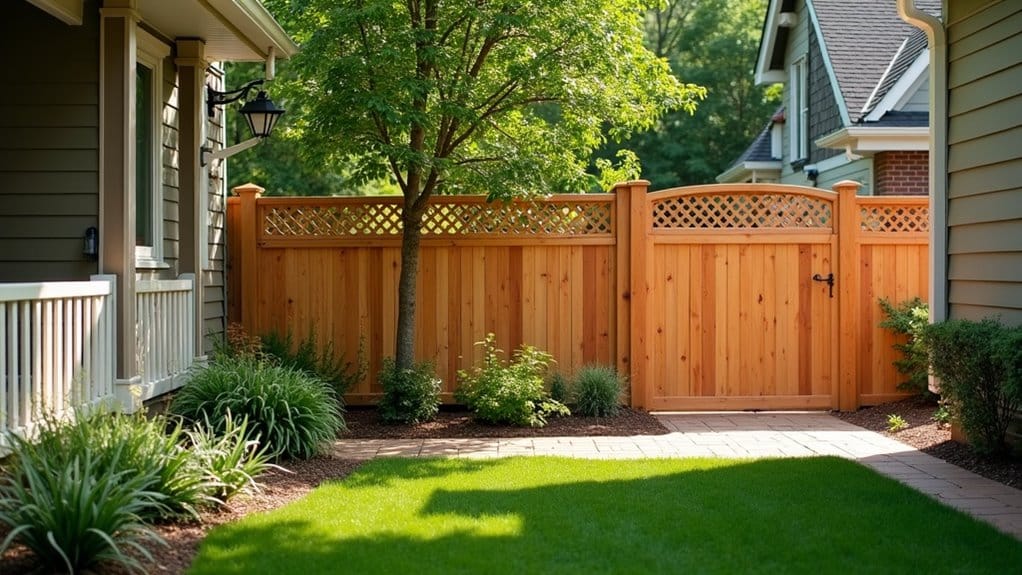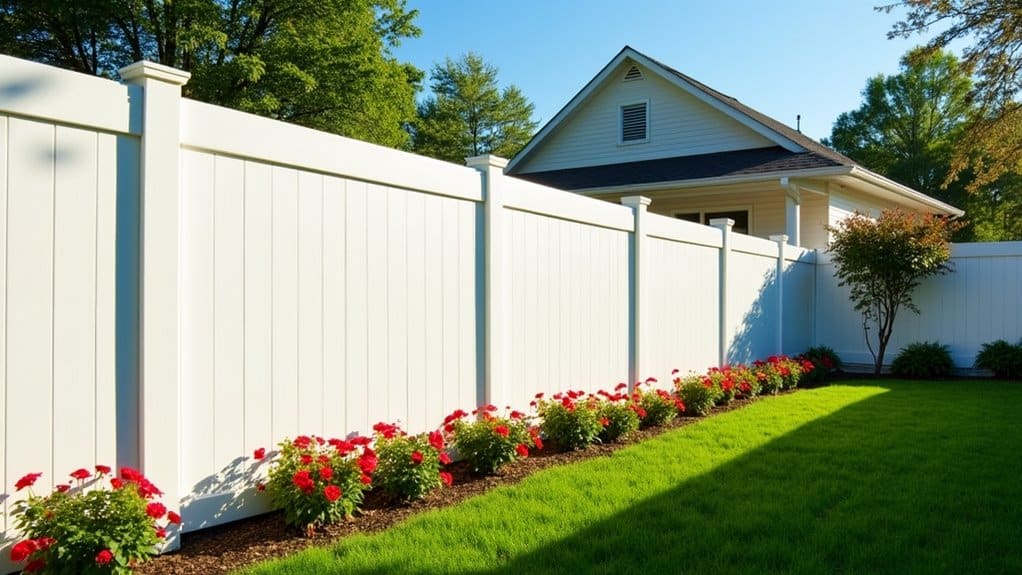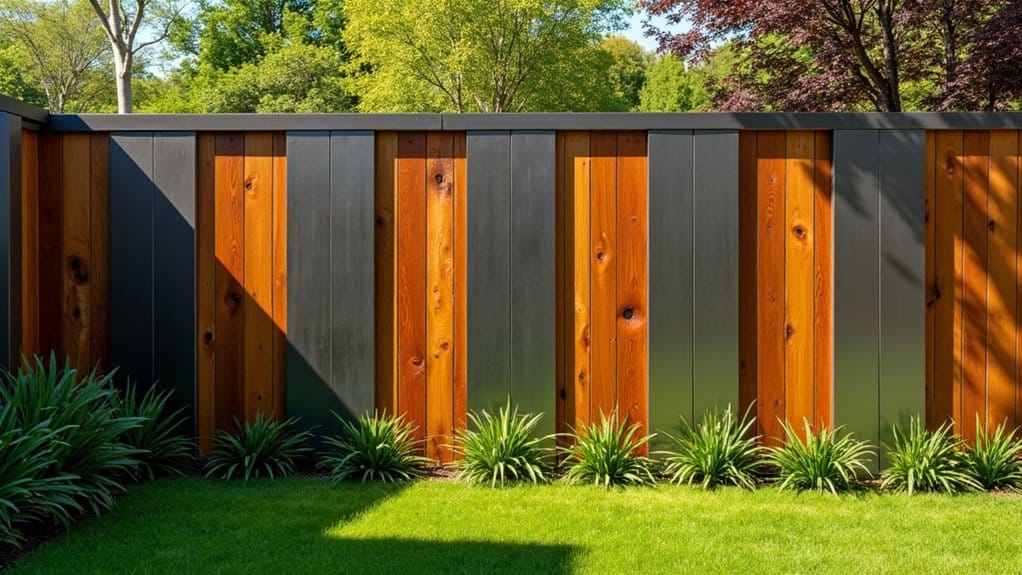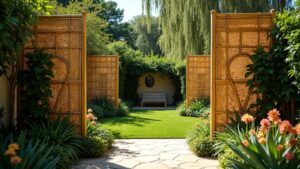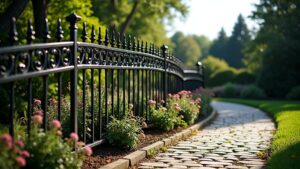When choosing a fence, weigh the pros and cons of wood and vinyl. Wood gives a classic, warm look but needs regular maintenance to avoid rot and pests, lasting about 15-30 years. Vinyl offers a modern appearance, is more durable (20-50 years), and requires minimal upkeep, resisting moisture and UV damage. While wood may cost less upfront, vinyl often saves you money in the long run due to its durability. Consider your style and local climate to find the right fit for your needs.
Key Takeaways
- Wood fences provide a classic, natural look and can be tailored to your style, but they need regular upkeep and can be susceptible to pests and decay.
- Vinyl fencing offers a sleek, modern appearance, is extremely durable, and requires very little maintenance, making it a more cost-effective option over time.
- In terms of lifespan, wood typically lasts 15-30 years with proper care, while vinyl can last 20-50 years with minimal attention.
- While wood has a lower initial cost, vinyl can save you money on maintenance and repairs in the long run, making it a smart investment.
- When considering environmental impact, remember that wood can contribute to deforestation, whereas vinyl, although long-lasting, presents challenges for recycling despite its resilience in tough conditions.
Durability Comparison
When deciding between wood and vinyl fencing, durability is key.
Wood fences last about 15 years, extending to 20 years with good care, while cedar can last up to 30 years, depending on the type and environment. However, they're vulnerable to rot, decay, and damage from pests and humidity. Furthermore, pressure-treated wood can extend the lifespan of wood fences by 5-10 years with proper maintenance. In contrast, vinyl fencing typically lasts 20 to 30 years with little maintenance. Its design makes it resistant to weathering, rot, and pests, so you won't need to worry as much about damage from insects or moisture. Additionally, vinyl is made from strong plastic, ensuring its longevity and resilience against various weather conditions.
If you want a low-maintenance, long-lasting option, vinyl is likely the better choice.
However, if you love the natural look of wood, be ready for some extra upkeep to keep it looking good.
Maintenance Needs
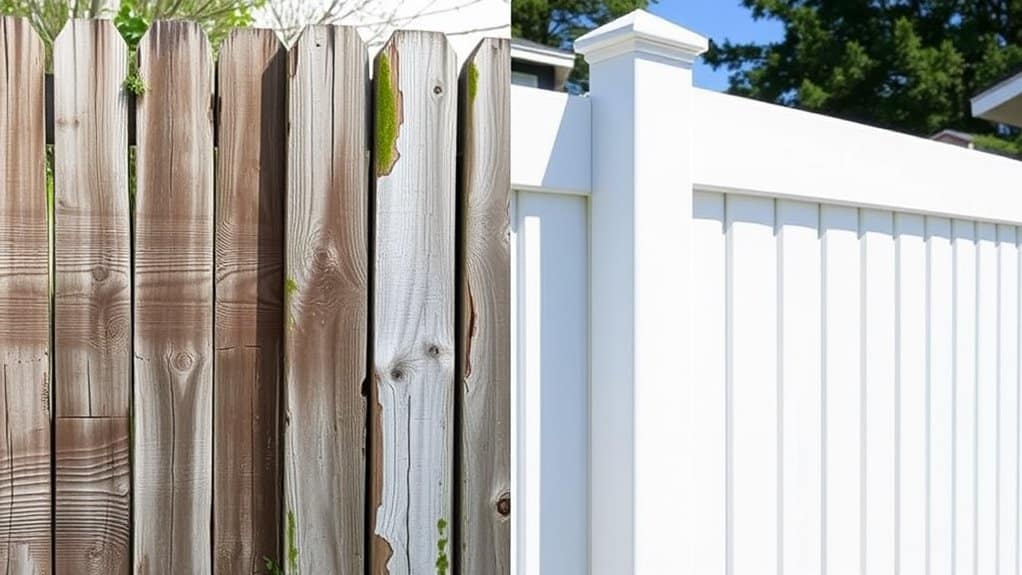
When deciding between wood and vinyl fences, maintenance is key.
Wood fences need regular staining, sealing, and cleaning to stay in good shape. Additionally, wood is prone to damage from pests, which can increase maintenance costs over time due to its lower durability compared to vinyl.
In contrast, vinyl fences only require occasional washing, making them much easier to maintain. Additionally, the long-term savings in maintenance and replacement costs for vinyl make it a more economical choice over time.
Consider these maintenance needs to choose a fence that suits your lifestyle and budget.
Vinyl Maintenance Advantages
Vinyl fences are a low-maintenance option for homeowners. Unlike wood, they don't require frequent repairs, allowing you to enjoy your outdoor space worry-free. PVC fences can last over 50 years, making them a durable choice for any property.
Cleaning is easy—just use a garden hose to rinse off dirt. For tougher stains, a mix of dish soap and water or a vinyl cleaner does the trick without harming the fence. Regularly clearing debris from the fence is essential to prevent buildup that can lead to more significant cleaning efforts later.
To keep your fence looking good, remove debris like leaves regularly. Annual checks are crucial to spot any wear and tear early. Additionally, since vinyl is resistant to termite damage, it offers peace of mind for homeowners.
If you find hard water stains or mildew, a combination of water and white vinegar can effectively clean those areas.
Wood Maintenance Requirements
Wood fences need regular upkeep to stay looking good and last longer. Start by inspecting for damaged, loose, or rotting boards and posts. Check for mold and ensure there are no loose screws or nails. If you spot significant damage, you may need to replace whole panels.
For cleaning, use a pressure washer with a low-pressure soap nozzle. Alternatively, mix one part bleach with three parts water, applying it with gloves and a scrub brush. Be careful not to harm nearby plants. Always test a small area first to make sure the pressure isn't too strong, and rinse well afterward. Inspecting for damage is crucial before you begin cleaning. Additionally, proper material choice and moisture protection can significantly extend the lifespan of your fence.
After cleaning, protect your fence with a wood sealant to guard against weather and UV rays. You might also want to stain it with an outdoor-specific product to reduce sun damage.
Remember to reapply the stain or sealant every 2-3 years to keep your fence looking great and enduring. Follow these steps, and your wood fence will serve you well for years.
Initial Cost Analysis

When selecting a fencing material for your home, it's essential to consider the initial costs. For wood fences, you can expect to pay between $1,743 and $4,431, with costs around $20 to $50 per linear foot. Labor can add another $14 to $37 per linear foot, depending on height and features. On the other hand, vinyl fences are generally more expensive, costing between $2,292 and $5,799, with an average around $4,045. Vinyl privacy fences typically range from $25 to $55 per linear foot, and installation can be more complex, resulting in higher labor costs. Initial installation costs for wood are generally lower due to simpler installation. Additionally, the minimal maintenance needed after installation of vinyl fences can make them a cost-effective choice in the long run.
Long-Term Cost Efficiency

When selecting a fence, consider both the initial cost and long-term expenses.
For example, wood fences often need frequent repairs and regular maintenance, which can become expensive over time. Additionally, the higher durability of vinyl fences helps to minimize the need for repairs, contributing to their cost-effectiveness.
On the other hand, vinyl fences may have a higher upfront cost, but their durability and low maintenance make them a more cost-effective choice in the long run.
Upfront vs. Ongoing Costs
When investing in a residential fence, it's important to balance upfront costs with long-term expenses.
Wood fences typically cost between $1,763 and $4,416, averaging around $3,065. Vinyl fences, on the other hand, have higher initial costs, ranging from $2,292 to $5,799, with an average of $4,045.
While wood may seem cheaper at first, it often requires ongoing maintenance to prevent decay, which can add up over time.
Vinyl fencing offers long-term savings. These fences are durable, resistant to weather, rot, and pests, and can last 20 to 30 years without needing replacement. Additionally, their strong durability minimizes the frequency of repairs or replacements, further enhancing their cost-effectiveness.
Plus, they require minimal maintenance—no staining or painting—leading to lower repair costs.
In summary, although vinyl has a higher upfront price, its long-term cost-effectiveness makes it a smart investment.
Consider both the initial price and future savings when making your decision.
Maintenance Cost Differences
Maintaining a fence can significantly affect your costs, especially when comparing wood and vinyl options.
Wood fences typically have higher ongoing expenses due to the need for regular upkeep, such as painting or staining every few years, which can cost between $200 and $500 annually. Plus, wood is susceptible to damage, leading to frequent repairs that can add up over time. Additionally, wood fences can be more susceptible to pests, which can further increase maintenance costs if not properly treated.
On the other hand, vinyl fences are much easier to maintain. A simple wash with soap and water is usually enough, costing around $100 to $200 per year.
Vinyl is resistant to rot and pests, which means fewer repairs overall. While replacing damaged panels can be pricey, the overall maintenance costs remain lower than those of wood.
Longevity and Replacement Considerations
Choosing a fence material goes beyond looks; it's about durability and replacement timing. Vinyl fences last 20-30 years, while wood fences typically last 15-25 years, depending on care. This difference affects how often you'll need to replace your fence and your overall costs.
Here are some key factors to consider:
- Cost vs. Value: Wood might be cheaper initially, but vinyl saves you money in the long run with less maintenance and fewer replacements.
- Durability: Vinyl resists moisture, insects, and UV damage, making it a solid long-term choice; this durability contributes to vinyl's longer lifespan compared to wood.
- Environmental Impact: Wood can contribute to deforestation, while vinyl is recyclable but not biodegradable.
- Maintenance: Wood requires regular upkeep to last, whereas vinyl needs minimal maintenance.
Investing in a vinyl fence can ultimately save you time, money, and stress, letting you enjoy your outdoor space without constant replacements.
Aesthetic Appeal
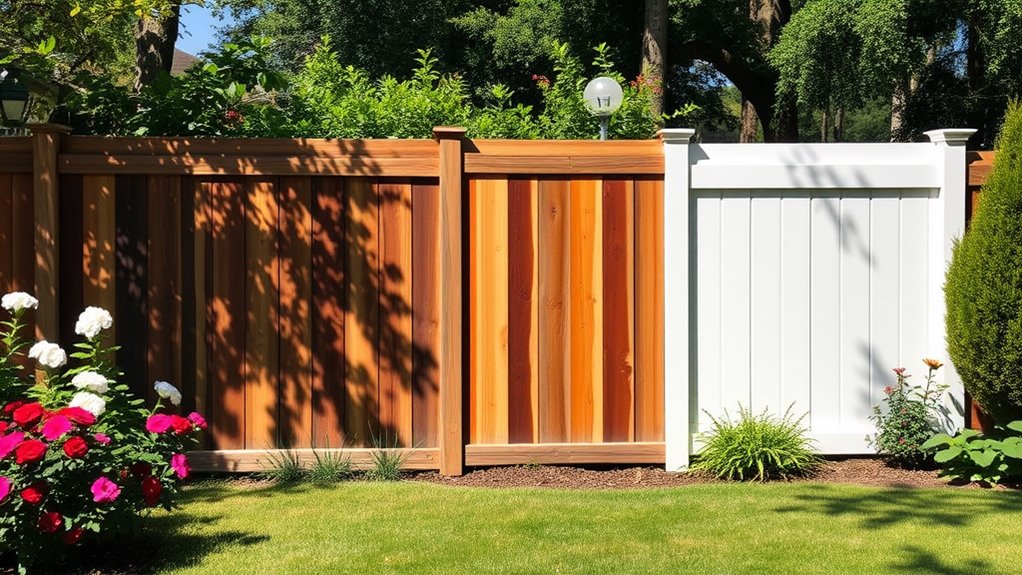
A fence can significantly improve your property's appearance, acting as both a boundary and a decorative feature.
If you like a classic look, wood fences provide natural charm and warmth, fitting well into various landscapes. You can choose from styles like picket, post and rail, or privacy fences, all of which can be customized with paint or stain to match your home's design.
For a modern touch, vinyl fences offer a sleek, contemporary option. Available in various colors and styles, including faux wood finishes, they combine the look of wood with long-lasting durability. Vinyl fences resist fading and peeling, requiring minimal maintenance.
Whether you prefer the rustic feel of wood or the clean lines of vinyl, both materials can enhance your property's overall aesthetic. Consider your style and your home's architecture to choose a fence that complements your space.
Installation Process
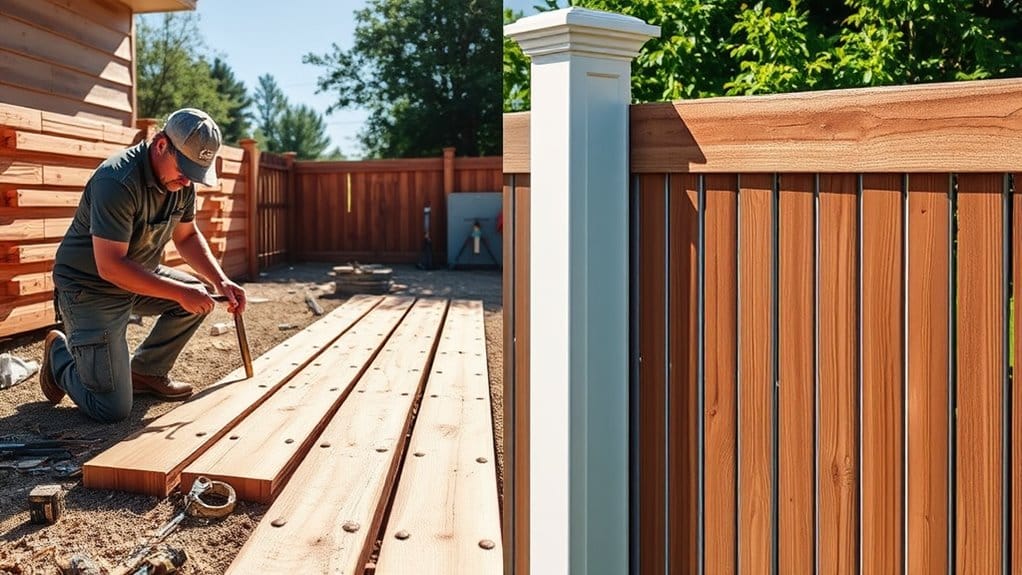
Installing your new fence requires careful preparation for a strong and attractive outcome.
Different materials come with various installation techniques, so it's important to know what you're working with.
If you're considering a DIY approach, familiarize yourself with the steps involved.
If you opt for a professional, understanding these basics will help you communicate your needs effectively.
Preparation Steps Needed
To start your fence installation smoothly and ensure durability, follow these essential preparation steps:
- Clear the Area: Remove any debris, rocks, and plants along the fence line. Level the ground and check for obstacles like roots or structures.
- Mark the Fence Line: Use stakes and string to outline where your fence will go. Place stakes at corners and ends, pulling the string tight to help with even post placement.
- Dig Post Holes: For wood fences, dig holes that are one-third the height of the posts plus an additional 6 inches for gravel. For vinyl, follow the manufacturer's guidelines, which typically require shallower holes.
- Set Posts: Position the posts in the center of the holes and ensure they're level. For wood, fill around the posts with concrete; for vinyl, use the specified connectors for panels.
Installation Techniques Compared
Choosing the right installation technique for your fence can significantly affect its durability and appearance. Here's a straightforward comparison of wood and vinyl fences:
| Feature | Wood Fences | Vinyl Fences |
|---|---|---|
| Post Installation | Requires deep holes and concrete for stability. | Similar method; posts are also set in concrete. |
| Panel Attachment | Pickets are attached individually, needing careful alignment. | Panels are usually pre-assembled for quicker installation. |
| Installation Tools | Uses screws, brackets, and a circular saw. | Uses clips or brackets for securing panels. |
| Aesthetics | Can be personalized with staining and sealing. | Offers a clean, uniform look with low maintenance. |
With wood, you'll spend more time ensuring everything is level, while vinyl allows for quicker installation without sacrificing strength. Your choice will depend on how much time and effort you're willing to invest.
Professional vs. DIY Options
When deciding between professional and DIY fence installation, consider the following:
- Professional Installation: Experts offer speed and durability, tackling complex setups and providing warranties for peace of mind.
- DIY Installation: You can save money and personalize your design while working at your own pace, which can be rewarding.
- Time and Convenience: Professionals finish the job quickly, while DIY allows you to take breaks and work around your schedule.
- Skills Required: DIY projects need some knowledge of installation and tools. Errors can lead to problems down the line, making professionals a safer bet.
Evaluate your skills, budget, and goals to choose the best route for your fence installation.
Environmental Considerations
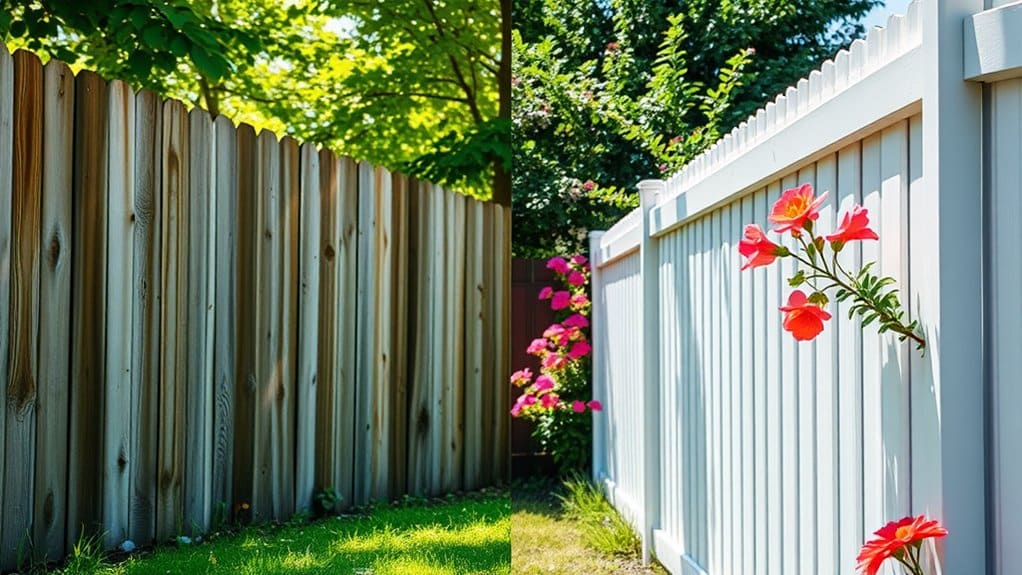
How does your choice of fencing material impact the environment?
Choosing wood often leads to deforestation, as it can take over ten mature trees to build just a 100-foot fence. This process takes centuries to replenish, especially with unsustainable practices.
Vinyl fences are low-maintenance and durable, but they're made from non-renewable resources like oil and natural gas, which contribute to harmful emissions.
Both materials have downsides. Vinyl is difficult to recycle and frequently ends up in landfills, despite improvements in recycling technologies.
If sustainability is a priority, consider recyclable wood-alternative options. Metal fences, such as those made from aluminum or steel, are highly recyclable and support a circular economy.
Your choice should balance aesthetics with long-term environmental impact. Making informed decisions can help you contribute to a sustainable future while enhancing your home's privacy and style.
Customization Options
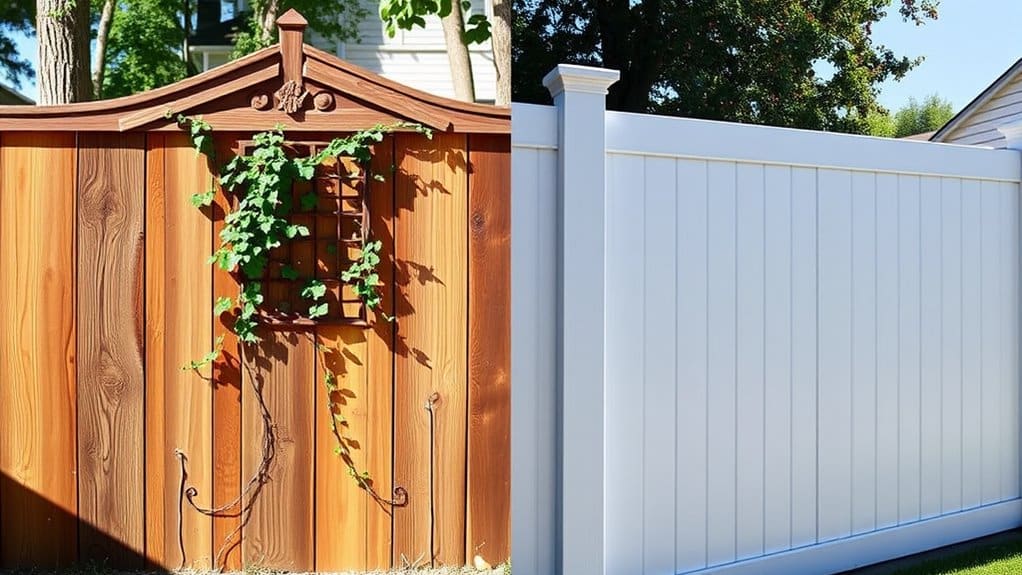
When it comes to residential fencing, you have plenty of customization options to match your style and needs.
Whether you choose wood or vinyl, there are various ways to make your fence unique.
Here are some key options to consider:
- Fence Styles: Select from styles like picket, board-on-board, or stockade for wood, and picket, screen, or post-and-rail for vinyl. Each style offers a different look and level of privacy.
- Color Options: Vinyl comes in many colors to match your home's exterior. With wood, you can stain or paint it to achieve your preferred appearance.
- Height and Design: Customize the height of your fence, from short decorative options to tall privacy barriers. Unique designs like lattice tops can enhance its visual appeal.
- Accessories: Add gates, arbors, or decorative post caps to improve both functionality and style. These personal touches can make your fence stand out.
With these choices, you can create a fence that perfectly fits your style.
Resistance to Weather
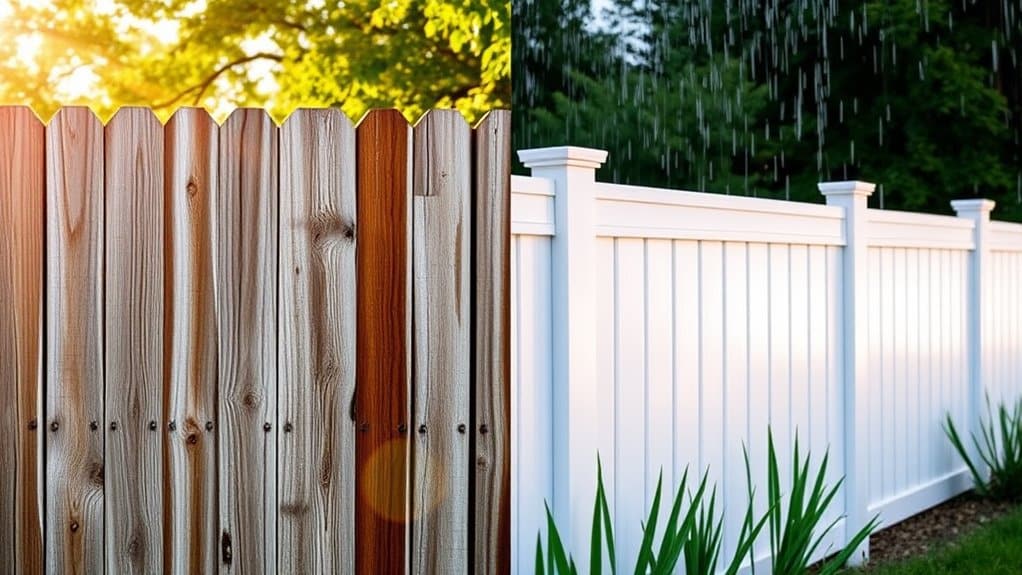
When choosing a residential fence, weather resistance is crucial.
Wood fences look great but can struggle in harsh conditions. They absorb moisture, leading to issues like swelling, warping, and decay, especially in humid or rainy areas. While some woods, like cedar and redwood, have natural oils that offer some moisture resistance, they still need regular sealing or staining to stay strong. Without proper care, mold and mildew can weaken the fence.
In contrast, vinyl fences excel in weather resistance. Made from high-quality PVC, they resist moisture and won't rot or swell.
Vinyl has a UV-resistant coating that prevents fading and brittleness, allowing it to withstand extreme conditions like heavy snow and strong winds. You won't have to worry about it absorbing water or becoming brittle in cold weather, making it ideal for areas with harsh climates.
If you're looking for a low-maintenance option that can endure the elements, vinyl is a smart choice.
Keep your local climate and maintenance preferences in mind when deciding.
Lifespan Expectations
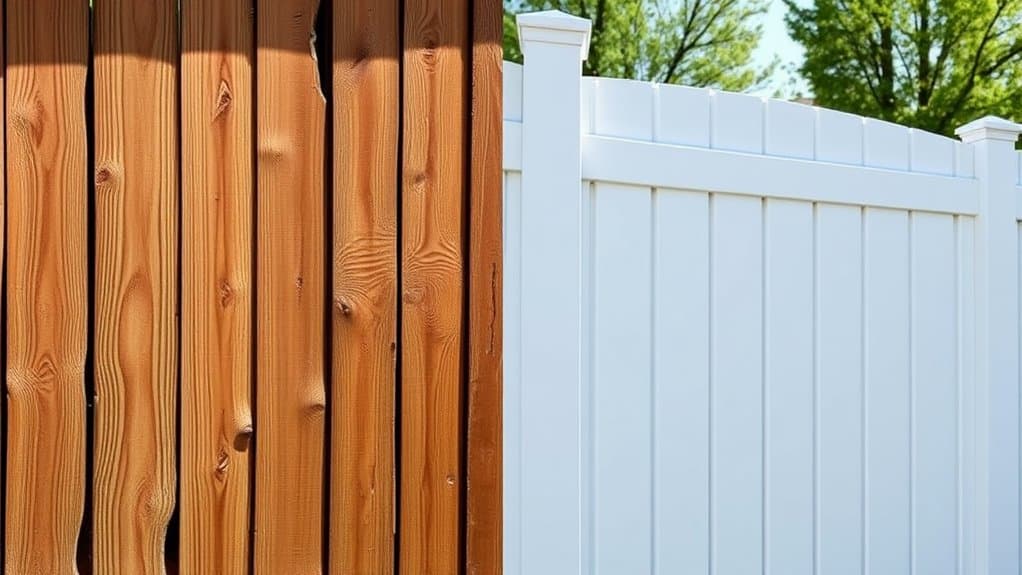
When choosing a residential fence, understanding lifespan expectations is crucial for your investment and satisfaction. Different materials have varying lifespans:
- Vinyl Fences: Typically last 20-30 years or more, especially if you opt for premium quality and keep them well-maintained.
- Wood Fences: Usually last 15-25 years, depending on the type of wood and maintenance. Environmental factors play a big role in their durability.
- Material Quality: High-quality materials are key. Vinyl is naturally durable, while good-quality wood can extend the life of a wooden fence.
- Maintenance Needs: Regular maintenance is vital. Wood needs protection from moisture through staining or sealing, while vinyl only requires occasional cleaning.
Resale Value Impact

A well-chosen fence can significantly boost your property's resale value, making it crucial for homeowners to consider their options.
When comparing wood and vinyl fencing, both can enhance your home's appeal, but they've different impacts on resale.
Wood fencing adds natural charm and can elevate curb appeal, especially when well-maintained.
However, it requires ongoing upkeep, which can reduce its value over time and lead to unpredictable returns on investment.
In contrast, vinyl fencing stands out for its durability and minimal maintenance.
It typically offers a higher return on investment—up to 65% over ten years.
Homes with vinyl fences often sell for more because buyers value the privacy and security they provide.
Personal Preference Factors
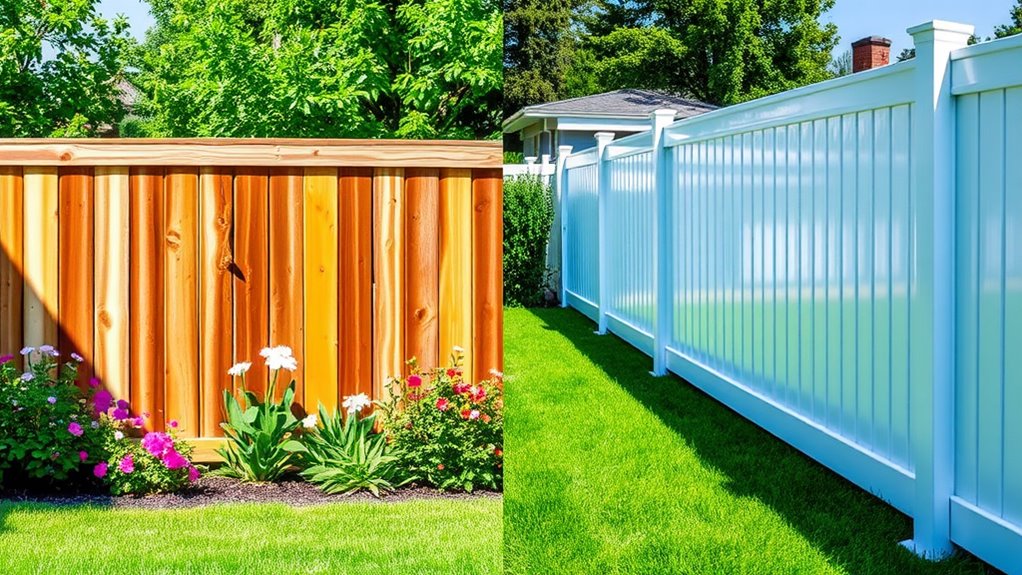
Choosing a fence is all about personal preference and how it fits with your home's style. Here are key factors to consider:
- Natural Look: A wood fence offers a timeless, organic feel that blends well with nature.
- Customization: Wood allows you to paint or stain it, so you can tailor its appearance to your liking.
- Maintenance: Think about how much upkeep you want. Vinyl fences require little maintenance, while wood needs more regular care.
- Environmental Impact: If being eco-friendly matters to you, wood is biodegradable and sourced from renewable materials.
Ultimately, choose a fence that reflects your aesthetic—whether that's the classic charm of wood or the modern toughness of vinyl.
Frequently Asked Questions
How Do Local Regulations Affect Fence Material Choice?
Local regulations significantly impact your choice of fence materials. For instance, zoning laws may dictate the height and type of materials you can use. If you want a wooden fence, check if it meets local safety standards. Failing to comply could result in fines or having to tear it down. Always make sure to obtain the necessary permits before starting your project to avoid complications.
What Are the Best Colors for Vinyl Fences?
When picking colors for vinyl fences, white offers a clean, fresh appearance, while gray adds a touch of sophistication. These shades are practical, as they conceal dirt better and need less maintenance compared to darker colors.
Can I Install a Fence Myself Without Prior Experience?
Yes, you can install a fence yourself, even if you've never done it before. Start by planning ahead and gathering the right tools. For example, a post hole digger and level are essential for a sturdy fence. Follow DIY guides to help you tackle any challenges. With careful preparation, you can complete the project successfully.
How Do I Choose the Right Fence Height?
To pick the right fence height, think about your privacy needs and check local rules. Look at what your neighbors have and consider your specific situation. Aim for a height that offers enough seclusion while following any legal limits. For instance, if you want to block views from a busy street, a taller fence might be best.
What Tools Are Needed for Fence Installation?
To install a fence successfully, you'll need key tools: a post hole digger, level, measuring tape, and cordless drill. These help ensure accurate measurements and secure posts for a straight, durable fence. Also, remember to wear safety gear!
Conclusion
When choosing between wood and vinyl for your fence, think about your priorities. Wood has a classic look but needs regular maintenance, like staining or sealing. Vinyl, on the other hand, is low-maintenance and durable, making it a great long-term choice. Consider how you want your outdoor space to look and function. By evaluating these factors, you can find the right material that fits your home's style and your lifestyle.

